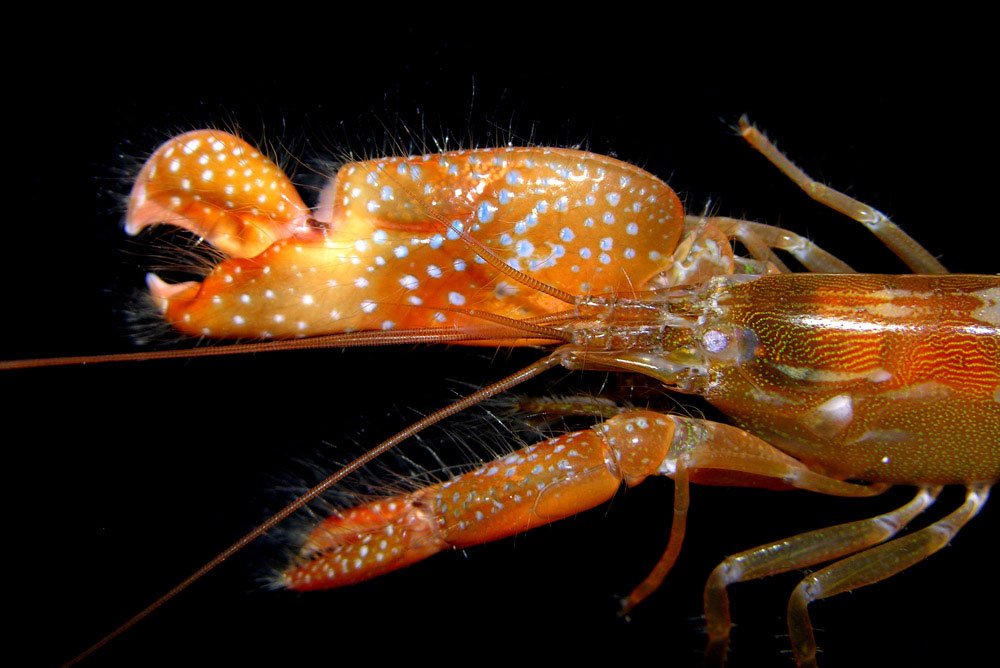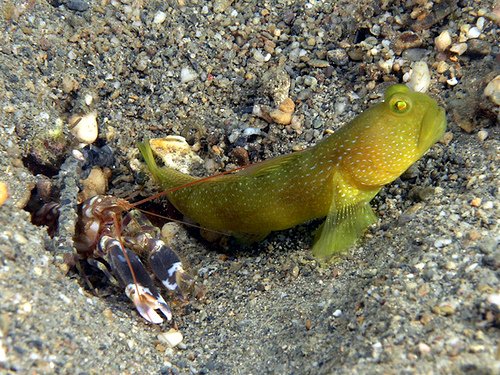Okay, so this obviously isn't a reptile, but our facility's aquarium department recently acquired a small number of pistol (or snapping) shrimp. These little guys are incredible aquatic hunters, and I wanted to do a short post about their amazing (and kinda freaky) adaptations.

Snapping shrimp are found throughout the world's oceans with more than 1100 species that we know of. Despite reaching sizes of only around 2 inches, these shrimp can certainly make a racket; in fact, they are among the loudest animals in the ocean, alongside the sperm whale and the beluga whale. When in large groups or colonies, they can make enough noise to interfere with sonar and underwater communication. How do they do it? The answer lies in a specially adapted claw.

They have asymmetrical claws, the larger of which creates the incredible noise. Rather than having a pincer-like structure at the end, the claw of the snapping shrimp is designed more like a pistol; a joint allows the "hammer" portion of the claw to move backward, into a right-angled position. When released, it snaps into the larger portion of the claw, creating the snapping sound that gives the shrimp its name. The snap also creates a powerful jet of bubbles, capable of killing small fish, stunning larger prey and even shattering glass (which is why our new acquisitions are at home in a thick, acrylic enclosure). Source
LinkThe "bubble-shot" is powerful for sure, but researchers have learned that more is happening during the instant of the shrimps' snap than we realized (this is where it gets CRAZY). The cavitation bubble released by the snap generates acoustic pressure that measures up to 80 kPa (kilopascals) and travels up to 62 miles per hour, generating a sound at 218 decibels! This is comparable to the battleship New Jersey firing all 9 sixteen inch guns at once (source) in a duration of less than one millisecond! The collapsing cavitation bubble is also capable of producing sonoluminescence; as it collapses, the temperature reaches around 5,000 K (4,700 °C)! In comparison, the surface temperature of the sun is estimated to be around 5,800 K (5,500 °C)(source)! The light produced is of a low intensity, not visible to the naked eye, and is likely a by-product of the shock wave (similar effects have been seen in the mantis shrimp, another cool little crustacean you should check out).
http://video.nationalgeographic.com/video/worlds-deadliest/deadliest-pistol-shrimp Link
Pistol shrimp occasionally share symbiotic relationships with goby fishes, living together as literal roommates. The shrimp digs and maintains a burrow, which it shares with the goby. The fish has better eyesight and is better able to watch for danger. The shrimp keeps its antennae in contact with the goby; if danger is spotted, the goby alerts the shrimp through a characteristic tail movement, and they both retreat to their shared home. With all these incredible adaptations, the snapping shrimp is one of the coolest and most underrated creatures in our oceans!


